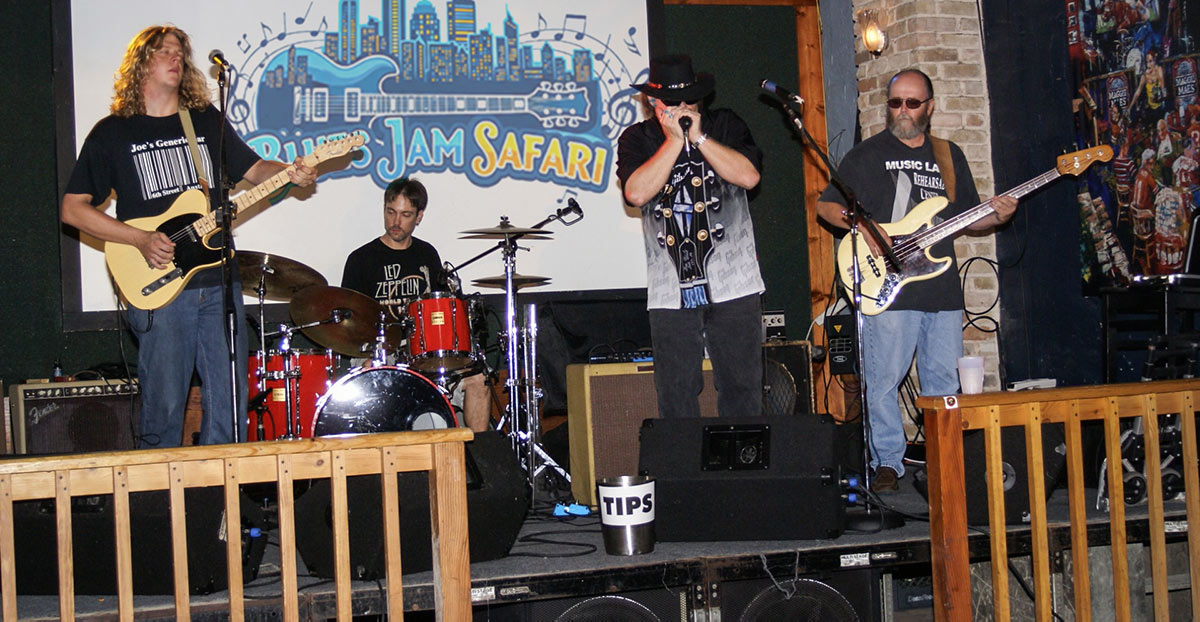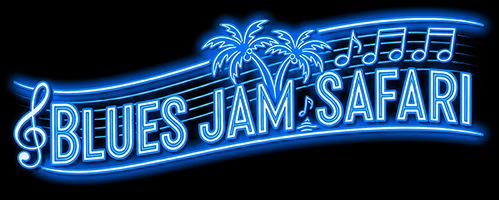First Two Chapters of Blues Jam Safari
Chapter 1
Stevie’s Shadow
They say lightning never strikes twice in the same place. Whoever said that never set foot in an Austin, Texas blues club in the 1980s.
In 1980, Stevie Ray Vaughan was just another hungry guitarist playing the smoky stages of Antone’s, his Stratocaster wailing the Texas blues to crowds that rarely topped a hundred. The locals knew. They’d crowd around rickety tables, nursing Lone Stars, watching those fingers fly across the fretboard, thinking they were witnessing something sacred.
They were right.
By the winter of ’84, after that weird set at the Montreux Jazz Festival, laying down tracks for David Bowie’s “Let’s Dance,” and unleashing his second album “Texas Flood” on an unsuspecting world, Stevie Ray wasn’t just playing the blues anymore—he was rewriting its future. The skinny kid from Oak Cliff had become a guitar god, trading licks with Clapton, swapping stories with B.B. King, and showing Johnny Winter a few thangs on the instrument they all thought they’d mastered.
The whispers became a roar. Austin, Texas was no longer just a college town wand the state capitol—it was hallowed ground for the blues. A promised land.
They came by the thousands. Guitar slingers from Chicago’s South Side, harmonica players from Mississippi juke joints, bass players from New York jazz clubs. They came from Tokyo and Toronto, London and Lagos. They abandoned steady jobs and skeptical families. They sold their possessions, packed their instruments, and pointed themselves toward that Texas horizon.
For what? For the chance to stand on the same stages, breathe the same air, chase the same ghosts. For the next thirty years, Austin became one continuous blues jam, a relentless parade of calloused fingers and hungry hearts. Some of the most gifted blues musicians on the planet crammed into apartments, worked day jobs, and lived for those nighttime hours when they could plug in and testify.
All of them hard working. All of them hard playing.
All of them chasing the same dream: to play the blues in Stevie’s shadow.

Chapter 2
First Time I Met the Blues
December of 1980. It was my first day in Austin, Texas. Eighty degrees on a beautiful Sunday afternoon. I had left the frozen corn fields of Iowa behind, traded snow for sun, and landed in a world that felt like a burnt orange fever dream. Fast and fit, right out of high school, unsure what my future held, maybe going to college, maybe not, I was drifting. Not exactly rudderless…but drifting. The current version of my plan was simple: a year hanging with my wealthy cousins, Dan and Dave—one year older, one year younger, respectively—establish residency in the great state of Texas while checking out Playboy’s “College Town of The Year” three years running, and then maybe dive into the hallowed halls of UT.
Aunt Bonnie greeted me in the driveway, eyeing my car before wrapping me in a warm embrace. “Look at you, all grown up. What are you, 18 now? You’re not skinny and short anymore!” She reached up and scruffed my shaggy blond hair.
I’d finally shed my childish frame, which had stuck around longer than welcome, now standing six feet tall and weighing just under 200 pounds. Years of farm labor had sculpted me – summer after summer of field work had transformed the scrawny kid into something solid.
My aunt guided me inside and cut straight to the chase. While we waited for my cousins to return, she quizzed me about my future plans. She expressed genuine delight that I’d managed to escape Iowa’s gravitational pull, assuring me I could make their home my own for as long as I needed.
That night, though, the plan took a detour. “Sixth Street,” Dan announced, a glint in his eye. “You gotta see this guitar player. Then we’re staying for the blues jam. So comb your pretty blond hair, put some faded denim on those white legs, we’re fixin’ to hit it in ten minutes.”
“Blues jam?” I asked, clueless. “What’s a blues jam?”
They just grinned, the kind of grin that promised something wild. “Let’s take the Camaro,” I said. My pride and joy; a pearl-white 1967 Camaro SS convertible, a rolling testament to my youth. As we cruised toward Sixth, I blasted my Pioneer stereo system, sharing my favorite road tunes: Van Halen, Seger, and AC/DC, the soundtrack of my journey from Iowa. That car, with its gleaming paint and powerful engine, was more than just transportation; it was a symbol of my newfound freedom, and I wanted to share that feeling with my cousins.
Downtown, we peeled off I-35, and they pointed to a dark, shadowy expanse beneath the highway. “Park here,” Dave said. “Everyone does.”
“Safe?” I asked, a flicker of unease as I wrestled the Camaro into the darkness.
“Safe enough,” Dan shrugged.
A little early for the music, we ducked into a daiquiri bar, where Dan and Dave knew a couple of the waitresses. The daiquiris were strong, potent, a taste of the sweet energy that seemed to permeate this city. Soon, it was time for live music. “Steamboat,” they said, “three blocks up Sixth.”
“I’ll grab the Camaro,” I said, eager to show off my ride. “Meet you there.”
When I got back to the car, the world had shifted. My pearl-white dream was shattered. The windows were smashed, the stereo ripped out, my cassette tapes gone. Before safety glass, a million tiny shards glittered like malevolent shark’s teeth in the dim light. Anger, raw and hot, surged through me. I brushed the glass away, a futile attempt to salvage something, then drove up Sixth Street past three blocks of dive bars and food joints to the blues jam, whatever the fuck that was, ready to blow a gasket.
I could hear the music from The Steamboat a block away. Outside, I was greeted by a yuppie with thinning, strawberry blond hair and a pointy chin and as I stormed passed him – he invited me in.
But inside, the anger died. It was just my cousins way in back , and directly to my left, a three-piece band that was loud, raw, and powerful. And there was this skinny, sweaty kid, his guitar howling, and crying, and weeping. I was stunned, mesmerized by a wall of power and this music I’d never heard before. I stopped, three feet from the stage, staring at him. The guitarist looked me in the eye and said, “Check this out.”
He lifted the guitar to his face and played the strings with his teeth. Then he played it behind his back. Then he knelt and laid the guitar on the floor and hammered the strings with his bare hand, not missing a beat, sweat flopping everywhere.
When the set ended, I went to the bar and bought two beers, walked to the stage, and handed one to him. “I’ve never heard music like that before,” I said, my ears ringing.
“What’s your name? What do you listen to?” the guitarist asked as he unplugged his amp from a floor socket.
I told him my name, just in town from Iowa, and about the Camaro, the stolen stereo, the cassettes, the mess.
“Gotchya.” The guitarist tiptoed over to a pile of gear behind his amp and pulled a harmonica from a small, green, nasty-looking army surplus bag. “If you lose something,” he said, handing it to me, “you gain something you never knew you had. Now you can play this in your car, Rick from Iowa.” He winked. “Learn Slim Harpo.”
“Stick around for the jam,” he said, winding some cords. “You’ll love my brother Jimmy’s band.”
“What’s your name?” I asked.
He took a long swig of the cold beer and said, “Stevie. Stevie Ray Vaughan.” Which explained the SRV sticker on his guitar.
We stayed. Before the music even started, the Steamboat was a sea of coeds, a restless hum filling the air, a sweet, intoxicating scent of perfume and sweat hanging heavy in the heat. Then, the Fabulous Thunderbirds took the stage: a “one, two, three” and then a sound that instantly transformed the room. The crowd exploded, bodies grinding together in a primal dance, driven by the irresistible groove. God, that groove. They called it “butt rockin’,” and it was a force of nature, a driving rhythm that stirred me to my core. The feeling was deep, raw, seductive, and loud.
And then, there was Kim Wilson. His harmonica, cupped in both hands in the smoky haze, cut through the groove with a tone that was pure, captivating fire. Each note, bent and vibrato-soaked, hung in the air, a primitive thrill. He moved with a swagger, a master of the stage, his presence as undeniable as the music. But it wasn’t just his playing and the music; to me it was a revelation, a seismic shift in who I was and what I wanted from life. Suddenly, I had a purpose. I had to learn to play that harp, to make that sound, to capture that feeling. God, that groove, that tone. It was everything.
The T-Birds played for an hour more and then brought up the musicians, “jammers” and had a blues party till two am.
Later, I talked to the musicians that played earlier. “How do you learn this?” I asked.
“Blues jams,” they said. “Go to the jams.”
I vowed to myself right then to do whatever it took to learn how to make that sound, play that amazing tone on the harp—and for the first time, I felt I had a center, a goal in life. Little did I know that the next thirty years would be a tumultuous journey, a whirlwind of exhilarating highs and crushing lows, all in the relentless pursuit of that powerful, strange, and beautiful music called—The Blues.
